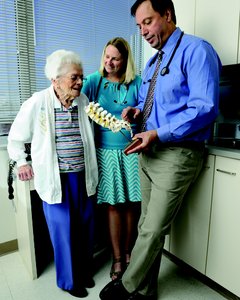Lois Thayer has never acted her age.
“She was still mowing her yard with a push mower at the age of 90,” daughter Judy Blair said, before adding that her mom said she would have continued longer but “my son-in-law asked to borrow my mower one day and I never got it back.”
While Lois appreciates her daughter and son-in-law’s watchful eyes, she likes living independently. A healthy and active 95-year-old, Lois was not happy when doctors told her that she would probably have to use a catheter for the rest of her life due to urinary retention (the inability to empty the bladder).
In November 2015, Lois was hospitalized in Champaign for three weeks after her kidneys nearly shut down. “That’s when doctors told her that her bladder wasn’t emptying like it should, and they put the catheter in,” Judy explained. When Lois’ bladder retention failed to improve during the hospital stay, doctors told Lois that the catheter would be permanent.
Weakened by the lengthy hospital stay, Lois spent several months in rehabilitation and then tried to adjust to life at home with a permanent catheter. “I didn’t like the idea of having to wear it all the time, and I didn’t feel like doing anything,” Lois said. Worse, she had to rely on her daughter for help changing it every morning and every evening.
Lois wanted a second opinion and was referred to Sarah Bush Lincoln Urologist David DiDomenico, MD, DO, FACS. He recommended InterStim® therapy, a neuromodulation therapy that targets problems with nerve responses moving between the bladder and the brain. The innovative therapy involves implanting an electronic device that acts like a pacemaker for the bladder. It is often used to help people who have not had success with medications or biofeedback options, Dr. DiDomenico said. While it is used more commonly for frequency and urgency issues, it is also effective in treating bladder retention as well as fecal incontinence.
Lois was eager to give it a try. She discreetly wore the small pager-sized instrument under her clothes for several days to ensure its effectiveness before it was implanted. “During this testing phase, if there’s at least 50 percent improvement with bladder emptying, then we say that patients are candidates to have the device installed,” Dr. DiDomenico said.
Lois and her daughter laughed about Dr. DiDomenico’s excitement when he discovered the device was working. “He came in the room laughing – pretty near dancing!” Lois said. “I think he was just as happy as I was. I was able to use the bathroom like normal.”
The following week, Lois had the device installed permanently through a small incision near her tailbone. The procedure was done on an outpatient basis under both local anesthesia and IV sedation. She was also given a programmer, which she can use to increase or decrease nerve stimulation.
‘The nice thing about this procedure is that it totally frees up the patient. We just see them if they have a problem and we need to make an adjustment,” Dr. DiDomenico said. “This was life-changing for her, because she had been sentenced to a catheter.”
Lois and her family are extremely happy with the outcome and want to make more people aware of the technology. Dr. DiDomenico has been using InterStim® therapy to help people since 2000 and is one of only a few urologists in the area who offer the procedure. InterStim® therapy has been FDA and Medicare approved since 1997.
“While it’s not effective for everyone, it’s important to note that there are options outside medications for people suffering from frequency, urgency and incomplete bladder emptying,” he said. “The technology is only getting better, and we are discovering new medications and techniques everyday.”
For more information or to make an appointment with Dr. DiDomenico, call the SBL Urology Clinic at (217) 258-4186

